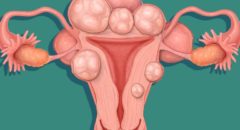
African-American women are disproportionately affected by uterine fibroids. We are three times more likely to have fibroids and tumors versus other races. Fibroids occur when tumors develop in the smooth muscle layer of the uterus. Fifty percent of women have them, however, most of the time they are benign.
READ: 90-Day Program May Help Eliminate Fibroids
Estrogen, and how it’s produced in your body, affects the growth of fibroids. Sometimes these tumors may not have symptoms associated with them. However, when symptoms are present, they may include abnormal and/or heavy menstrual cycles, pain during or after sex, and more pressure on your pelvic area.
You may have been diagnosed with uterine fibroids or know someone who has them. Personally, I have a mother, sister, and close friend who have had fibroids and who each made different decisions about which treatment option. Their decisions were based on the goal and outcome they wanted to achieve. The good thing is that there are numerous options which might work for you.
Here are some treatments options for fibroids that have proven to be the most effective.
First, let's list some Natural Treatments:
A. Avoid Foods that Make Fibroids Worse
Foods to eliminate or limit in order to reduce your risk for fibroids include high-fat, processed meats. High-fat, processed meats are some of the worst food choices for women when it comes to fibroids. Foods high in unhealthy fats, like non-organic/processed meats or trans-fats (think hamburgers and processed breakfast sausages), can increase inflammation levels.
Processed foods also often contain chemical additives and other ingredients that promote inflammation. Limit the amount of meat you eat by also including plant-based protein in your diet.
B. Supplements that Aid in Fibroid Reduction
- Vitex (4,00mg 2 times daily). Vitex or chasteberry reduces estrogen levels by promoting the production of progesterone. For best results, vitex should be taken for at least six months.
- Fish Oil (1,000 milligrams daily) or Flaxseed Oil (1 tablespoon daily). The essential fatty acids found in fish oil and flaxseed oil can help reduce inflammation in your body, which may play a part in fibroid growth.
- B-complex (50 milligrams daily). If B vitamins are lacking in the diet, the liver is missing some of the raw materials it needs to carry out its metabolic processes and regulate estrogen levels.
- Progesterone Cream (1/4 teaspoon, days 6–26 of cycle). Applying progesterone cream topically can help balance out low progesterone. When treating fibroids, it’s important to work with a doctor who has tested your hormone levels so you can be best advised if natural progesterone cream is the right option for your body.
- Milk Thistle (150 milligrams 2 times daily). Aids body in liver detoxification, which can balance hormones.
Now, here are some traditional treatment options:
Treatment Option 1: Myomectomy Fibroid Surgery
In this procedure, only the fibroid tumor(s) is removed. Your uterus and other organs stay intact. This is a surgical procedure in which an incision is done via your stomach area via laparoscopic surgery or using a hysteroscopy (a viewing tool) via your vagina. While the fibroid may come back some years later, this option allows you to remove your fibroid and keep your fertility intact.
READ: Chrisette Michelle Opens Up About Living With PCOS
Treatment Option 2: Use Medication
Lupron is a commonly used medication to lessen hormonal stimulation. This serves a two-fold purpose. Lupron helps to shrink the size of your fibroids and it also helps to decrease some of the heavy bleeding associated with fibroids. The downside is that this treatment can only be used up to nine months. Once you stop taking the medication, the fibroids return. If a woman is close to menopause, Lupron can be a good option since the fibroids may shrink naturally once a woman enters menopause.
Treatment Option 3: Emobilization of the Uterine Artery
In this procedure, blood flow is blocked to the fibroid, which causes the fibroid to shrink in size and eventually die. The procedure is conducted using a catheter. The catheter is placed into the uterine arteries and particles which are very small in size are injected which causes the blocked blood flow to the tumor. This procedure is more ideal for a woman who has already had children and does not plan to have additional kids.
READ: How & Why Fibroids Affect Black Women Differently
Treatment Option 4: MRI-Guided Ultrasound
For this option, physicians use ultrasound waves which are high focused and convert to heat to destroy the tumor. The radio waves are guided by the MRI to where the tumors exist in the uterus and pelvic region. During this procedure, you are sedated and placed inside an MRI machine. This procedure generally takes about three hours. The heat destroys the tumor, but this may involve multiple sessions. For women who have completed childbearing, this may be a good alternative. If a woman is looking to have children, this procedure has some risks, including potential damage to other organs and fertility issues for future pregnancies.
Treatment Option 5: Ongoing Medical Monitoring of the Fibroids
If you decide you do not want to undergo a surgical procedure, or do not have many symptoms associated with your fibroids, monitoring may be the choice for you. This is a procedure when you check your fibroids for size and the number of them at regular intervals. This is done using a vaginal ultrasound exam along with a blood test for anemia. Monitoring for anemia is important because when you become anemic, it means you are not developing enough healthy red blood cells.
This option can work if your fibroids are not manifesting many symptoms, if a woman is done having children or does not want children, or when you are near menopause.
Whatever you decide to do for your fibroid treatment, take into consideration your fertility, the downtime you want to experience with each surgical procedure and the outcome you want. Once you factor in these considerations, you will make an informed decision and one that suits you best.








